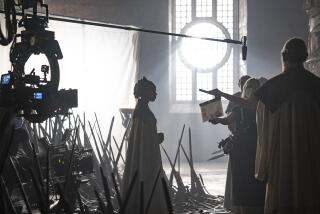AN 80-YEAR PACKET OF BRITISH FILMS
- Share via
Nothing like an all-American movie like, say, “Raiders of the Lost Ark” to make a body feel proud of Hollywood and American cinema, right? A true Yankee production . . . except for the British special-effects artists, the British production teams, the British sets and the British actors.
Actually, much of Hollywood’s past and present product has more than a touch of the Union Jack in its closing credits: The success of many a recent film owes a great deal to Britain’s support and technical personnel--as well as its actors, directors and writers.
The close alliance of the two film industries is a point underscored by “The British Film Collection,” an exhibit on view (through March 21) at the Academy of Motion Picture Arts and Sciences.
More than 80 years of British film is chronicled in the exhibit, which features more than 200 still photographs, posters, costumes and other memorabilia. The collection toured Britain last year and will move on to Cannes in time for its film festival later this year.
But author/curator Patricia Warren said the wide selection of artifacts on display at the academy is only a fraction of the material she collated for her book, “The British Film Collection 1896-1984.”
“There were just huge piles of the stuff when I began (the book),” Warren said in a recent interview. “It was an incredible adventure rounding up all the materials. I went tramping through archives, film libraries, jumble (garage) sales, every place I could think of.”
Through primarily visual means, the exhibit covers the development of British film from the earliest film “exhibitions” through director Alfred Hitchcock’s British period (for example, he directed the first British “talkie,” “Blackmail,” in 1929), the war years--when part of Shepperton Studios was turned over to aircraft manufacturing--and on to “Gandhi,” “Chariots of Fire” and “Monty Python’s The Meaning of Life.”
In addition to the predictably lush stills of such British film figures as Chrissie White, Leslie Howard, Laurence Olivier, Vivien Leigh and Gertrude Lawrence, the exhibit offers glimpses into the British studio process. An early photograph shows a film studio circa 1920 with its roof open to the sky and various pieces of black cloth suspended from the rafters--an early substitution for klieg lights, no doubt.
But the exhibit also marks the decline in the 1970s of the British studios--Elstree, Ealing, Shepperton, Pinewood and others, mostly centered around Twickenham, a London suburb, where curator Warren lives--and the growing interest these held for the American film industry as a place to shoot historical films, interiors and special-effects footage. Paralleling developments in America, longstanding ownership of the British studios gave way to corporate management. As an example, Thorn-EMI, a huge British entertainment concern, now owns Elstree Studios, where much of the “Star Wars” trilogy--especially its ground-breaking special-effects work--was filmed.
As Warren pointed out, contemporary British films are doing well at both countries’ box offices, however, and some hope glimmers on the horizon for the once-moribund industry. “It’s not all gloom and doom,” she said. “More and more, British films are entirely self-produced and self-created, and that’s good news for us in Twickenham.”
Warren, who also writes children’s television shows and often represents Britain at foreign film festivals, said her original plan was not so encyclopedic as “The British Film Collection” (both the book and the subsequent exhibit) wound up becoming.
“Originally, I had wanted to write something quite specific for television, something about Elstree in the 1920s,” Warren recalled. “When I set about to do a little research, though, I found that none of it had been organized, so I started putting what I had together--and wound up with a book (‘Elstree, British Hollywood’).” Once she got going, she said, she found it “near impossible” to stop.
“There’s one more book in me, I think,” Warren continued. “This one will examine the linkage between the British and American film industries. When I spoke at the opening of the exhibit in London, I said I finally came to realize how intertwined Twickenham and Hollywood were, from the actors to the producers to the distributors. So you see, this exhibit isn’t just about Britain. It’s about film itself, and how it’s made and sold. How, as it were, the spell of the cinema is cast.”
More to Read
Only good movies
Get the Indie Focus newsletter, Mark Olsen's weekly guide to the world of cinema.
You may occasionally receive promotional content from the Los Angeles Times.










